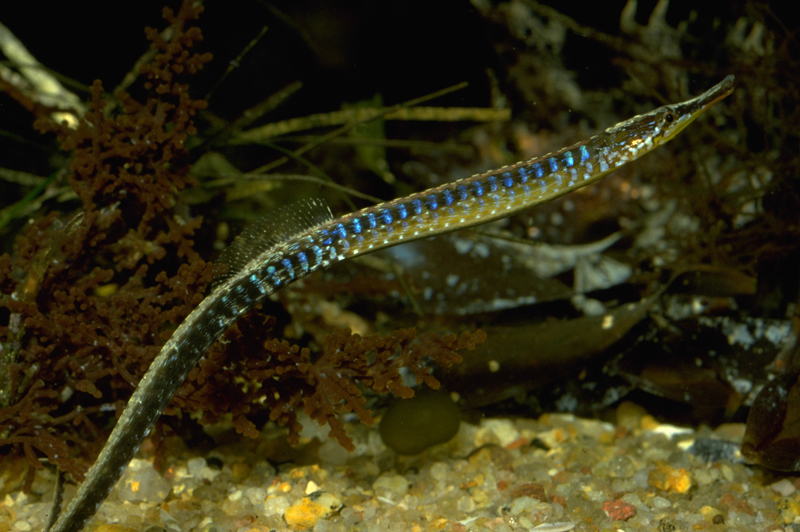Port Phillip Pipefish, Vanacampus phillipi (Lucas 1891)

A Port Phillip Pipefish, Vanacampus phillipi. Source: Rudie Kuiter / Aquatic Photographics. License: All rights reserved
A brownish pipefish with indistinct bars and spots. Females have blue bars on the upper sides and along the tail, especially larger individuals. The underside of the head of females usually has irregular dark spots or streaks, while it is pale in adult males.
Port Phillip Pipefish, Vanacampus phillipi (Lucas 1891)
More Info
|
Distribution |
|
|
Features |
Dorsal fin 22–29; Pectoral fin 9–12; Anal fin 3–4; Caudal fin 10; trunk rings 17–20 (usually 18); tail rings 38–46; subdorsal rings 2.00–0.00 + 4.50–6.75 = 5.75–8.00. Body elongate, trunk shallow; head aligned with body; snout moderately long, length 41–56% HL, depth 14–33% snout length; median dorsal snout ridge not confluent with supraorbital ridge; longitudinal opercular ridge usually complete; superior trunk and tail ridges discontinuous near rear of dorsal-fin base; inferior trunk and tail ridges continuous; lateral trunk ridge not confluent with tail ridges; tail not prehensile. Dorsal fin slightly closer to tip of snout than to tip of tail, base of moderate length; anal fin tiny, below anterior portion of dorsal fin; caudal fin small; pectoral fin present. |
|
Size |
To 20 cm SL. |
|
Colour |
|
|
Feeding |
|
|
Biology |
Males brood the eggs in an enclosed pouch on the underside of the tail just behind anal fin; usually fewer than 50 eggs per brood. |
|
Conservation |
Marine listed under the Environment Protection and Biodiversity Conservation Act 1999 (EPBC Act). Listed as protected under the New South Wales, Victorian, Tasmanian and South Australian Fisheries Management Acts. |
|
Remarks |
Reported to be a relatively strong swimmer. |
|
Similar Species |
|
|
Etymology |
|
|
Species Citation |
|
|
Author |
Bray, D.J. & Thompson, V.J. 2021 |
|
Resources |
Port Phillip Pipefish, Vanacampus phillipi (Lucas 1891)
References
Dawson, C.E. 1984. Synopsis of Australian pipefishes usually referred to the syngnathine (tail-pouch) genera Syngnathus, Leptonotus and Histiogamphelus. Memoirs of Museum Victoria 45: 71-123 [Plates 1-9]
Dawson, C.E. 1985. Indo-Pacific Pipefishes (Red Sea to the Americas). Ocean Springs (Mississippi) : Gulf Coast Research Laboratory 230 pp. 293 figs pl. 1.
Dawson, C.E. 1994. Family Syngnathidae. pp. 440-475 figs 391-426 in Gomon, M.F., Glover, C.J.M. & Kuiter, R.H. (eds). The Fishes of Australia's South Coast. Adelaide : State Printer 992 pp. 810 figs.
Edgar, G.J. 2008. Australian Marine Life: the plants and animals of temperate waters. Sydney : Reed New Holland 2nd edn, 624 pp.
Howard, R.K. & Koehn, J.D. 1985. Population-dynamics and feeding ecology of pipefish (Syngnathidae) associated with eelgrass beds of Western-Port, Victoria. Australian Journal of Marine and Freshwater Research 36: 361–370, https://doi.org/10.1071/MF9850361
Jenkins, G.P. & Wheatley, M.J. 1998. The influence of habitat structure on nearshore fish assemblages in a southern Australian embayment: comparison of shallow seagrass, reef-algal and unvegetated sand habitats, with emphasis on their importance to recruitment. J. Exp. Mar. Biol. Ecol. 221: 147-172.
Kendrick, A.J. & Hyndes, G.A. 2005. Variations in the dietary compositions of morphologically diverse syngnathid fishes. Envir. Biol. Fishes. 72: 415–427.
Kuiter, R.H. 1993. Coastal Fishes of South-eastern Australia. Bathurst : Crawford House Press 437 pp.
Kuiter, R.H. 1996. Guide to Sea Fishes of Australia. A comprehensive reference for divers and fishermen. Sydney, NSW, Australia : New Holland Publishers xvii, 434 pp.
Kuiter, R.H. 2000. Seahorses, Pipefishes and Their Relatives. Chorleywood, UK : TMC Publishing 240 pp.
Kuiter, R.H. 2008. Syngnathidae. pp. 448-479 in Gomon, M.F., Bray, D.J. & Kuiter, R.H. (eds). Fishes of Australia's Southern Coast. Sydney : Reed New Holland 928 pp.
Kuiter, R.H. 2009. Seahorses and their relatives. Seaford, Australia : Aquatic Photographics pp. 331.
Last, P.R., Scott, E.O.G. & Talbot, F.H. 1983. Fishes of Tasmania. Hobart : Tasmanian Fisheries Development Authority 563 pp. figs. (as Syngnathus phillipi)
Lucas, A.H.S. 1891. On the occurrence of certain fish in Victorian seas, with descriptions of some new species. Proc. Roy. Soc. Vic. (ns)3(2): 8–14, See ref at BHL
McCulloch, A.R. 1911. Report on the fishes obtained by the F.I.S. Endeavour on the coasts of New South Wales, Victoria, South Australia and Tasmania. Part 1. Zoological (Biological) Results. Endeavour 1(1): 1-87 figs 1-20 pls 1-16 (as Corythoichthys phillipi)
Rachinski, T. & Pollom, R. 2016. Vanacampus phillipi. The IUCN Red List of Threatened Species 2016: e.T65375571A67622360. http://dx.doi.org/10.2305/IUCN.UK.2016-1.RLTS.T65375571A67622360.en. Downloaded on 25 September 2018.
Waite, E.R. 1921. Illustrated catalogue of the fishes of South Australia. Records of the South Australian Museum (Adelaide) 2(1): 1-208 293 figs pl. 1
Waite, E.R. 1928. Check list of the marine fishes of South Australia. Journal of the Pan-Pacific Research Institute 3(1): 3-13
Whitley, G.P. & Allan, J. 1958. The Sea-horse and its Relatives. Melbourne : Georgian House 84 pp. 25 figs. (as Parasyngnathus phillipi)





